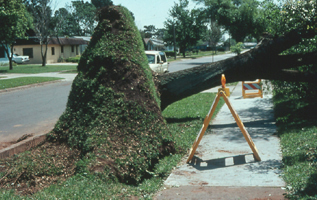Home > Site analysis > Evaluate below-ground characteristics > Rooting space restrictions
Rooting space restrictions
 Trees with roots restricted to an island of soil become more stressed than those that can expand roots under pavement. |
Match ultimate tree size to size of the planting space to keep trees healthy and prevent damage to surrounding sidewalks, curbs and pavement. Some horticulturists suggest that at least 2 cubic feet of soil is required to support each square foot of canopy area (ground surface area outlined by the edge of the branch canopy) under nearly ideal conditions (Lindsey and Bassuk, 1992).
This means that by knowing the ultimate canopy size desired for a particular planting site, you
could
calculate the required soil volume for adequate root growth. The site
could then be designed to provide for this amount of soil.
This concept has significant implications for urban spaces that are designed to support trees. If we expect trees to provide shade to pavement in urban landscapes, we must create favorable conditions for root growth under pavement or deeper in the soil. These conditions must be created during the planning and design phase of a project. It is usually very difficult to engineer these conditions into the site once it is built.
See: More information on planting space guidelines for parking lots and streets.
 In this case, limiting the root space for the tree had dangerous consequences. Photo courtesy Andy Kitsley. |
It is not always apparent if soil can support root growth, especially in highly disturbed sites beneath pavement. Soil under pavement is typically poorly aerated and compacted, a situation that is considered inhospitable for roots, unless it is sandy and well drained.
Roots will be mostly confined to the soil space
not covered by pavement. This could stunt growth if the tree is completely surrounded
by pavement. However, some wet-site tolerant trees such
as honeylocust and elms are adapted
to produce roots under pavement; many other trees are not adapted.
Roots often grow directly under pavement along cracks. Trees with roots under pavement are likely to be less stunted than those with roots confined to a small island. The next chapter will discuss alternate site designs might can enhance root growth under pavement.

